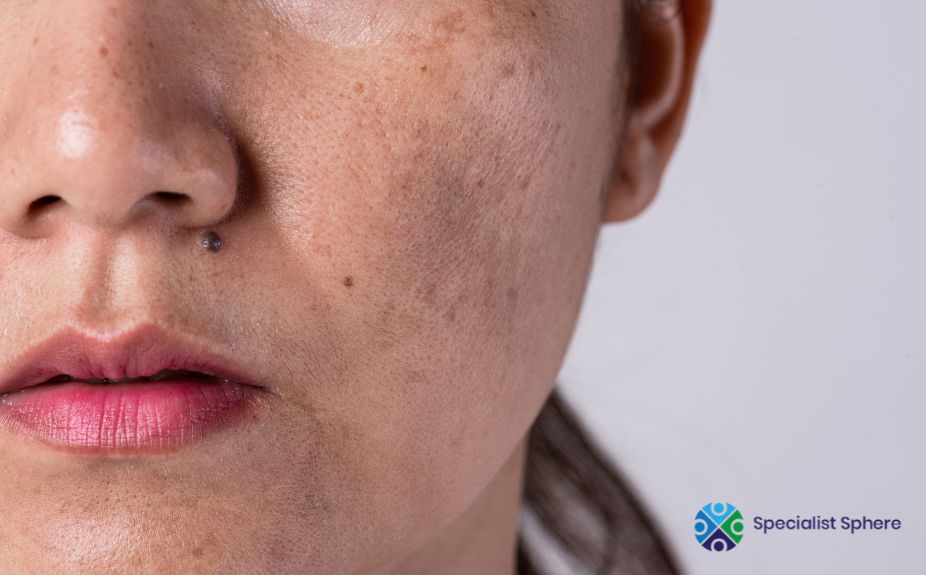What is Hyperpigmentation and What Causes It?
Hyperpigmentation is a common skin condition where patches of skin become darker than the surrounding areas. This happens when there is an overproduction of melanin, the natural pigment responsible for skin color, in specific spots. While it can affect anyone, people with certain skin types may be more prone to it.
What are the common types of hyperpigmentation?
- Age Spots / Sun Spots: These are typically caused by prolonged sun exposure and are most common on areas like the face, hands, and chest.
- Melasma: Often called the “mask of pregnancy,” melasma is triggered by hormonal changes, sun exposure, and sometimes certain medications.
- Post-Inflammatory Hyperpigmentation (PIH): This type occurs after a skin injury, such as acne, a rash, or a burn, leaving behind a dark mark as the skin heals.
Understanding IPL Treatment for Hyperpigmentation
What is IPL and how does it work to treat dark spots?
Intense Pulsed Light (IPL) is a non-invasive cosmetic procedure that uses broad-spectrum light to target and break down excess melanin in the skin. The IPL device emits powerful light pulses that are specifically absorbed by the melanin in darkened areas. This light energy converts to heat, which effectively shatters the pigment particles. Over time, your body’s natural processes clear away the fragmented pigment, revealing a more even skin tone.
Is IPL a laser?
No, IPL is not a laser. While both use light to treat skin concerns, a laser uses a single, focused wavelength of light. IPL uses a broad spectrum of wavelengths, allowing it to treat a wider range of skin issues like redness, fine lines, and sun damage in addition to hyperpigmentation.
Key Benefits of IPL for Fading Hyperpigmentation
1. Targeted and Precise Treatment
IPL technology is designed to selectively target pigmented cells. The light energy is absorbed by the darker melanin, minimizing impact on the surrounding, lighter skin. This precision makes it an effective solution for issues like age spots and sun damage.
2. Minimal Downtime
One of the greatest advantages of IPL is the minimal downtime. Most patients can return to their daily activities immediately after their session. You may experience some mild redness or swelling, but this typically subsides within a few hours to a couple of days.
3. Treats Multiple Areas of the Body
IPL is incredibly versatile. While it’s a popular treatment for facial hyperpigmentation, it can also be safely and effectively used on other sun-exposed areas. Common treatment areas include:
- The face
- Neck
- Chest (décolletage)
- Hands
4. Addresses Multiple Skin Concerns
In addition to fading dark spots, IPL can also improve overall skin texture, reduce the appearance of fine lines, and minimize redness caused by broken capillaries. This makes it a comprehensive solution for achieving a more refreshed and youthful complexion.
Your IPL Treatment Journey: What to Expect
Before Your IPL Session
How do I prepare for IPL treatment?
To ensure the best and safest results, you’ll be asked to:
- Avoid sun exposure and tanning beds for at least 2-4 weeks before your appointment.
- Discontinue self-tanners.
- Pause certain skincare products, such as those containing retinoids or exfoliating acids, as advised by your aesthetician or doctor.
During and After Your Treatment
What happens during an IPL session?
A typical IPL session lasts about 20-30 minutes, depending on the size of the area being treated. A cooling gel is applied to the skin, and you’ll wear protective eyewear. The device is then gently pressed against the skin, delivering quick pulses of light that may feel like a rubber band snapping.
What results can I expect and when will I see them?
Immediately after treatment, the targeted dark spots may appear darker, a sign that the treatment was successful. This temporary darkening is normal. Over the next 1-3 weeks, these spots will gradually flake off or fade away, revealing a clearer skin tone. For significant results, a series of 3-5 sessions, spaced about a month apart, is often recommended.
Post-Treatment Care: Maintaining Your Results
How do I care for my skin after IPL?
- Sunscreen is non-negotiable: Apply a broad-spectrum sunscreen with an SPF of 30 or higher every single day, especially after treatment.
- Avoid direct sun exposure: Limit your time in the sun, wear hats, and seek shade to protect your treated skin and prevent new hyperpigmentation from forming.
- Gentle skincare: Avoid using harsh exfoliating products or scrubs for several days after your session.
Conclusion: Is IPL Right for Your Hyperpigmentation?
For many people, IPL offers a safe and effective solution for combating hyperpigmentation, particularly sun damage, age spots, and freckles. With minimal downtime and a proven track record, it’s a powerful tool for achieving a brighter, more even skin tone.
Ready to take the first step toward a clearer complexion? Schedule a personalized consultation with a skincare professional to determine if IPL is the right treatment for your unique skin concerns.


